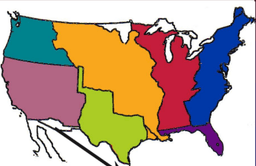
Sectionalism
Quiz by Franshicka Banks-Brown
Feel free to use or edit a copy
includes Teacher and Student dashboards
Measure skillsfrom any curriculum
Measure skills
from any curriculum
Tag the questions with any skills you have. Your dashboard will track each student's mastery of each skill.
With a free account, teachers can
- edit the questions
- save a copy for later
- start a class game
- automatically assign follow-up activities based on students’ scores
- assign as homework
- share a link with colleagues
- print as a bubble sheet
19 questions
Show answers
- Q1How were the economies of the north and south different?North was based on agriculture and slavery while the South was based on industries and factoriesNorth was based on mining and the South was based on agriculture and slaveryNorth was based on industries and the South was based on miningNorth was based on industries and factories while the South was based on agriculture and slavery30s
- Q2Why did Northern states not want slave states to join the Union?Free states would have more power in Congress.Border states would have more power in Congress.The power in Congress would be balanced between free and slave states.Slave states would have more power in Congress.30s
- Q3How did the Missouri Compromise satisfy the North?by adding Missouri, a slave state, to the Unionby adding Missouri, a free state, to the Unionby adding Maine, a slave state, to the Unionby adding Maine, a free state, to the Union30s
- Q4How did the Missouri Compromise satisfy the South?by adding Maine, a slave state, to the Unionby adding Maine, a free state, to the Unionby adding Missouri, a free state, to the Unionby adding Missouri, a slave state, to the Union30s
- Q5Under the Missouri Compromise, land above what line could not have slavery?20' 2636' 30'26' 20'30' 36'30s
- Q6The Wilmot Proviso fought to stop the spread of slavery in the ...SouthNorthWestEast30s
- Q7Under the Compromise of 1850, which state was added to the Union as a free state?CaliforniaNebraskaMissouriTexas30s
- Q8The Fugitive Slave Act was enacted under the Compromise of 1850. The Fugitive Slave Act ...allowed runaway slaves to vote in important electionsreturned runaway slaves to their owners and threatened the freedom of free African Americansreturned runaway slaves to Canada where they could be freeallowed abolitionists to help runaway slaves to freedom30s
- Q9The Kansas-Nebraska Act allowed settlers to decide on the issue of slavery by using popular sovereignty. What does that mean?settlers were able to vote on the issue of slaverymembers of the House of Representatives decided the issue of slaveryThe senator decided if Kansas would be a slave state or free state.30s
- Q10After the Kansas-Nebraska Act was enacted, pro-slavery and anti-slavery settlers moved to Kansas to fight for control of the territory. Why did Kansas become known as "Bleeding Kansas?"Because the color of dirt in Kansas was the same color as blood.Because pro-slavery and anti-slavery settlers fought constantly. More than 200 people were killed.Because the territory's flag was mostly red.Because Kansas is the French word for "Bleeding."30s
- Q11Who was John Brown?a pro-slavery Senator who beat an anti-slavery Senator with a canea pro-slavery settler who came up with the Missouri Compromisean abolitionist who moved to Kansas to make it a free state. He led an attack on Harper's Ferry but was captured and killed.an abolitionist who tried to stop the spread of slavery in the west with the Wilmot Proviso30s
- Q12Who was Dred Scott?an abolitionist known as "The Great Compromiser"an abolitionist who led a revolt on Harper's Ferrya slave who fought for his freedom by taking his case to the Supreme Courta slave who is known as the most well-known conductor of the Underground Railroad30s
- Q13Did Dred Scott win his case? How did the Supreme Court rule?yes; since he was considered a human, he had the right to fight for his freedomno; since he was considered property, he had no right to file a lawsuityes; since he lived in a free state, he was considered a free manno; since he was born in Canada, he had to be returned to slavery in Canada30s
- Q14Who did Abraham Lincoln challenge to a series of debates?David WilmotHenry ClayStephen DouglassJohn Brown30s
- Q15What happened to John Brown after he led an attack on Harper's Ferry?He was captured by Ulysses S. Grant but later set freeRobert E. Lee helped him with his raid and he later escaped to Canada.He was captured by Robert E. Lee and hangedUlysses S. Grant arrested him and put him in jail in Kansas.30s